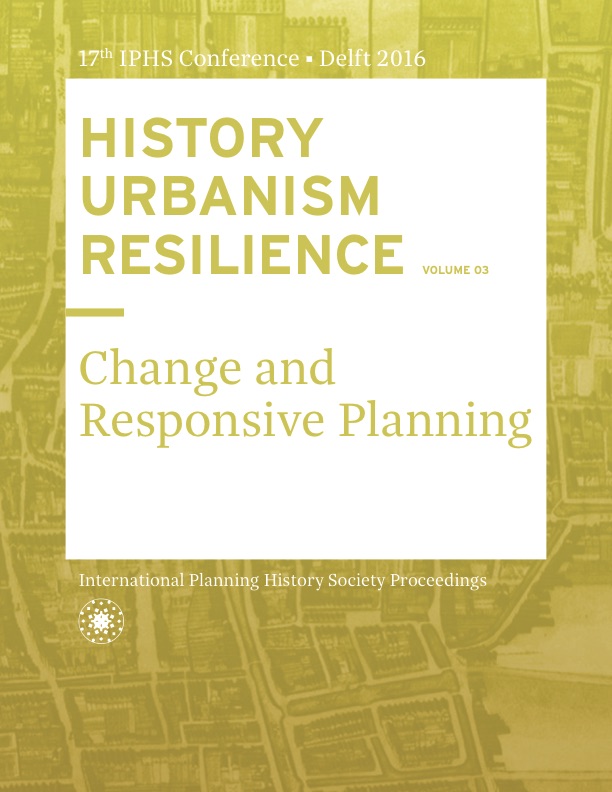Tabula rasa meets resilience: urban reconstruction and the dilemmas of the modern planning in Chillán, Chile (1939)
DOI:
https://doi.org/10.7480/iphs.2016.3.1272Abstract
On January 24, 1939 an intense earthquake -equivalent to 7.8 degrees on Richter scale- shattered the city of Chillán (Chile) killing 20,000 people and implicating the destruction of the economic basis of a large region of the country, involving some 600 km long. This devastation resulted in the complete reorganization of prevention systems, planning and reconstruction, giving rise to new government structures and policies related to both urban development and the possibilities of restoring urban dynamics.The paper will present, on the one hand, the new institutional structures developed from the experience, including the Corporación de Fomento (CORFO) -an institution created to promote the reconstruction of regional and national economy, based on Keynesian principles for intervention and state’s promotion as regards economy and industrial production- and the Corporación para la Reconstrucción y Auxilio (CRA) -an agency concerned with the physical reconstruction of infrastructure, towns and cities; integral regional and urban planning and financial and credit management, both for the public and private sphere.
On the other, at the urban level -and particularly in the case concerning the reconstruction of Chillán- urban visions were varied. Among those, the protagonists were only two: tabula rasa and traditional planning. Planning alternatives and its ideas will be presented, including the failure to develop the destroyed cities plans by Le Corbusier and a significant proposal by Waldo Parragués, following the same corbusian ideas established in the ‘Ville Radieuse’ project. At the same time, the more definitive strategies contemplated a model of plan that would set the basis for the establishment of analytical and operational planning nationwide, via the Dirección General de Obras Públicas Planning Section.
The debate for the reconstruction of Chillán called for various urban approaches, forms and figures of modern planning, aiming to a model that incorporated both the dimensions of a new way of organizing the city, as the aspects related to its future capacity of resisting an earthquake similar to that occurred in 1939, mainly by means of zoning in relation to soil resistance and construction technologies possible to be used in public and private buildings.
References
Bibliography
Bannen, Pedro; Pérez Oyarzún, Fernando; Vásquez, Claudio. “Entendidos, subentendidos y malentendidos sobre urbanismo moderno: alternativas del frustrado viaje de Le Corbusier a Chile”. In Massilia 2004. Anuario de estudios lecorbusieranos; ed. Josep Quetglas; (Barcelona: Fundación Caja del Colegio de Arquitectos de Cataluña, 2004).
Bartelt, Natalie. “Binnenmarktförderung als Entwicklungsstrategie : staatliche Industrialisierungspolitik in Chile durch die Corporación de Fomento de la Producción (CORFO) 1939 – 1952”. Magisterarbeit, Freie Universitët, Berlin, 1999.
Bastiancig, Agostino. “El terremoto del 24 de enero de 1939 en Chile. Observaciones y consideraciones relacionadas con la edificación”. Scientia. Vol. V. (1939).
Gebhard, Enrique. “Urbanismo y habitación”. ARQuitectura N° 2. (1935) : 15-23.
Müller Biscar, Martín. “The public sector and the Chilean industrialization process: an analysis of CORFO during the period, 1939-1973”. MA diss., University of Texas at Austin, 1978
Le Corbusier. La Ville Radieuse. Éditions de l’Architecture d’Aujourd’hui, Boulogne-sur-Seine, 1935.
Muñoz Maluschka, Luis. “Corporación de Reconstrucción y Auxilio Ley 6334”. Urbanismo y Arquitectura nº 2 (1940): 55-56
Muñoz Maluschka, Luis. “Concepción dinámica del urbanismo, espacios vitales urbanos”. Urbanismo y Arquitectura Vol.2. N°10, (1940) : 46
Oehrens, Federico. “A proposito de Le Corbusier”. Diario Frente Popular. February 11, 1939.
Parraguéz, Waldo. “Estudio de Reconstrucción de la Ciudad de Chillán”. Suplemento Dominical La Hora, March 26, 1939.
Parraguéz, Waldo. “Los modernos principios del urbanismo deben aplicarse al reconstruir la ciudad de Chillán”. Sección Arquitectura La Nación. March 29, 1939
Torrent, Horacio. “Ciudades en papel: Teorías arquitectónicas y urbanas en Chile 1930-1940”. In: Revistas, Arquitectura y Ciudad: Representaciones en la Cultura Moderna. Horacio Torrent, ed. (Pamplona: T6 Ediciones; 2013) : 127-155.
Torrent, Horacio. “La revista ARQuitectura y la transformación del campo disciplinar: Vanguardia, cuestión social, planificación urbana y arquitectura moderna”. In: Las revistas de arquitectura (1900-1975): crónicas, manifiestos, propaganda. Héctor García Diego, ed. ( Pamplona, España.: T6 Ediciones; 2012) : 319-326.
Ulricksen, Guillermo. “La tierra liberada para edificar”. Diario Frente Popular. February 15, 1939.
Ulricksen, Guillermo. Ordenanza Local de Urbanización de Chillán, 1943. Dpto. Técnico. Sección Urbanismo. Corporación de Reconstrucción y Auxilio. Santiago, 1946.

